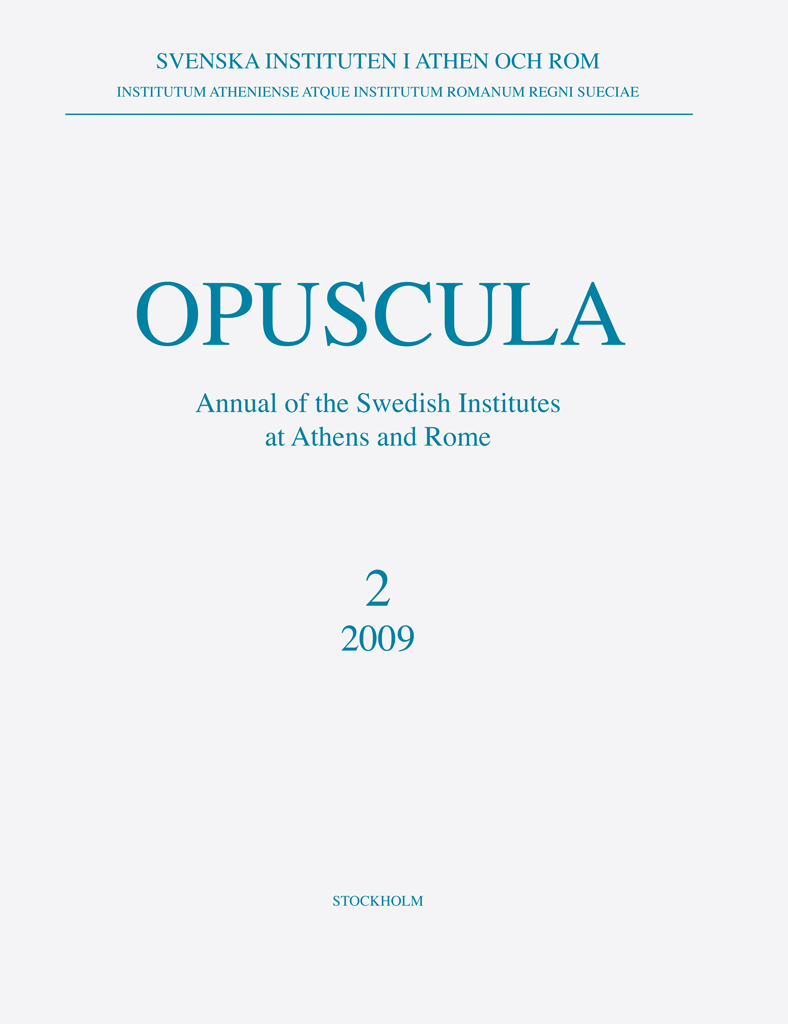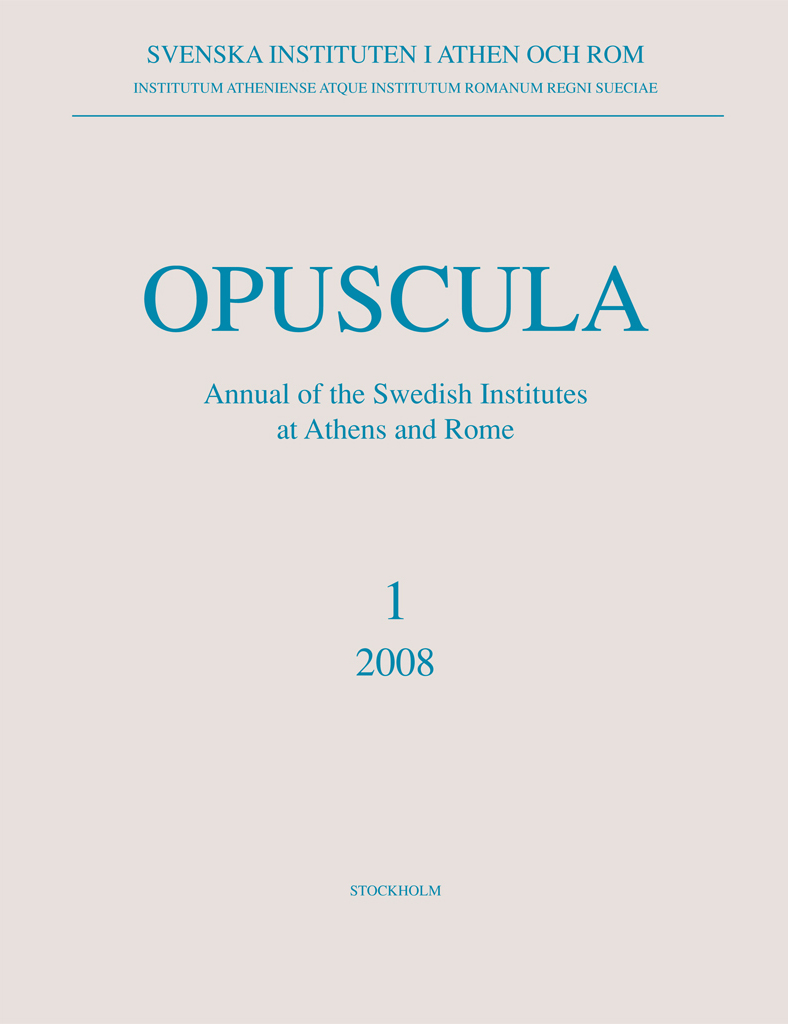Opuscula 2 (2009) is now available for purchase and free download at Bokorder.se. Also available at Amazon.com, Amazon.de, Bokus.com and Adlibris.com. Excavations in Midea 2007 By Katie Demakopoulou, Nicoletta Divari-Valakou, Monica Nilsson & Ann-Louise Schallin Abstract Excavations in Midea continued in 2007 as a Greek-Swedish programme under the direction of Dr Katie Demakopoulou in collaboration with Dr Ann-Louise Schallin. In the West Gate area excavation continued in the west part of the building complex that abuts the fortification wall. Room XIV was excavated with abundant remains of LH IIIB2 pottery. A sealstone with a unique, possibly ritual, scene was also found. On the lower west terrace of the acropolis excavation continued in Trench C, where a large section of the fortification wall was uncovered. Room I was excavated here, adjacent to the inner face of the fortification wall. Finds in this room date to the early phase of LH IIIC, under which there was ample evidence of the LH IIIB2 destruction, including human skeletons. Under this debris, a large opening leading to a gallery or syrinx through the thickness of the fortification wall was found. Excavation was resumed also in the East Gate area, where a new wall was revealed…
Opuscula 1 (2008) is out of print. Available for free download at Bokorder.se. Used copies might be available at Amazon.com and Amazon.de. Die Büste eines Afrikaners aus der Sammlung Piranesi in Stockholm By Carmen Marcks Abstract A portrait bust of an African placed among the antiquities in the Royal Museum at Stockholm once belonged to the Roman artist Giovanni Battista Piranesi. It was brought to Sweden at the end of the 18th century at the instance of King Gustav III. The head is a work of the middle or second half of the 16th century. It belongs to a specific, local, Roman form of Mannerist portraits, which have in common a remarkable affinity to antique imperial portrait busts. While the head is an eclectic work combining an idealized countenance—a contemporary peculiarity of portrait art—with antique usages of portrayal, the bust itself seems to be a work that stands directly in the tradition of cinquecentesque Venetian busts. Obviously head and bust were not originally created as an ensemble. This contribution is only available in print. Bibliographical information Carmen Marcks, ‘Die Büste eines Afrikaners aus der Sammlung Piranesi in Stockholm’, Opuscula. Annual of the Swedish Institutes at Athens and Rome (OpAthRom) 1,…
Opuscula 1 (2008) is out of print. Available for free download at Bokorder.se. Used copies might be available at Amazon.com and Amazon.de. I muri trasversali di Santa Croce in Gerusalemme e la sinagoga di Ostia By Olof Brandt Abstract The reasons behind the unusual internal division of the first phase of the church of Santa Croce in Gerusalemme have never been fully explained. This paper proposes an explanation of the phenomenon with the help of a comparison with the Synagogue of Ostia Antica. Bibliographical information Olof Brandt, ‘I muri trasversali di Santa Croce in Gerusalemme e la sinagoga di Ostia’, Opuscula. Annual of the Swedish Institutes at Athens and Rome (OpAthRom) 1, 155–166. Stockholm 2008. ISSN: 2000-0898. ISBN: 978-91-977798-0-7. Softcover, 198 pages. https://doi.org/10.30549/opathrom-01-12
Opuscula 1 (2008) is out of print. Available for free download at Bokorder.se. Used copies might be available at Amazon.com and Amazon.de. Reconsidering the tomb of Aulus Hirtius By Henrik Gerding Abstract Since its discovery, the tomb of Aulus Hirtius in Rome has been regarded as a firmly dated monument and, thus, constituted a widely used fixed point for those tracing the early development of Roman brick architecture. However, several peculiarities regarding the construction of the tomb and its inscriptions strongly indicate that the present dating, which is based on historical sources, may not be correct. In this note it is suggested by the author that the original tomb was destroyed and thoroughly remodelled in the early or mid-Augustan period. Some general implications of this regarding the introduction of brick architecture in Rome are also considered. Bibliographical information Henrik Gerding, ‘Reconsidering the tomb of Aulus Hirtius’, Opuscula. Annual of the Swedish Institutes at Athens and Rome (OpAthRom) 1, 145–154. Stockholm 2008. ISSN: 2000-0898. ISBN: 978-91-977798-0-7. Softcover, 198 pages. https://doi.org/10.30549/opathrom-01-11
Opuscula 1 (2008) is out of print. Available for free download at Bokorder.se. Used copies might be available at Amazon.com and Amazon.de. A forgotten tomb at Hippokome and its neighbours By Paavo Roos Abstract A rock-cut tomb in Hippokome on the Lyco-Carian border was overlooked in an earlier survey and is published here, together with an adjacent blind door and two niches with sockets for stelai beside it, and another tomb and a niche in the vicinity. Bibliographical information Paavo Roos, ‘A forgotten tomb at Hippokome and its neighbours’, Opuscula. Annual of the Swedish Institutes at Athens and Rome (OpAthRom) 1, 137–144. Stockholm 2008. ISSN: 2000-0898. ISBN: 978-91-977798-0-7. Softcover, 198 pages. https://doi.org/10.30549/opathrom-01-10
Opuscula 1 (2008) is out of print. Available for free download at Bokorder.se. Used copies might be available at Amazon.com and Amazon.de. Nuovi dati sul popolamento nella pianura di Tarquinia durante la romanizzazione. Il caso della località “Il Giglio” By Maria Gabriella Scapaticci Abstract During works for a communal athletic-ground at Tarquinia in the district “Il Giglio”, which took place between 2000 and 2001, some slight remains of ancient structures of the Late-Republican and Early-Imperial Age were accidentally discovered. The Soprintendenza per i Beni Archeologici dell’Etruria Meridionale then undertook extensive excavations, documenting a farm and an interesting hydraulic system, part of which had already been found not far from there, at Tarquinia in the district “Gabelletta”. The part of the plain of Tarquinia that is located at the foot of the hill, where Corneto was later established in the Middle Ages, was intensively cultivated with a drainage system and very extensive canalizations, because of the natural fertility of the soil and the richness of water-supplies in this region. It is thus likely that the flax for which Tarquinia was famous in antiquity was cultivated in these fields, and that, towards the end of the second Punic War, this farmland supplied…
Opuscula 1 (2008) is out of print. Available for free download at Bokorder.se. Used copies might be available at Amazon.com and Amazon.de. Materiali inediti da Sovana. Alcuni corredi funerari dalla necropolis di San Sebastiano By Gabriella Barbieri Abstract Hellenistic pottery, found in four Etruscan chamber tombs in Sovana, is presented here. The most interesting vessels are some jugs, decorated with a floral pattern, that were produced locally in the third century B.C. A black-glazed plate contains an inscription that is the oldest Latin epigraphic document of Sovana and it shows the slow process of Romanization of an Etruscan town in the first century B.C. This funeral complex is interesting because of the lack of documentation at Sovana, that is perfectly preserved. This contribution is only available in print. Bibliographical information Gabriella Barbieri, ‘Materiali inediti da Sovana. Alcuni corredi funerari dalla necropolis di San Sebastiano’, Opuscula. Annual of the Swedish Institutes at Athens and Rome (OpAthRom) 1, 105–122. Stockholm 2008. ISSN: 2000-0898. ISBN: 978-91-977798-0-7. Softcover, 198 pages. https://doi.org/10.30549/opathrom-01-08
Opuscula 1 (2008) is out of print. Available for free download at Bokorder.se. Used copies might be available at Amazon.com and Amazon.de. Visualized rituals and dedicatory inscriptions on votive offerings to the nymphs By Milette Gaifman Abstract This article explores the religious meaning of Archaic and Classical dedications with images of rituals (e.g. sacrificial procession, libation) and dedicatory inscriptions. I argue that these objects ought to be treated as meaningful expressions of individuals’ piety rather than as reflections of actual cult practices. I adopt a holistic approach that considers the two components of dedications—images and texts—as inextricably intertwined in the creation of meaning. The argument is exemplified through the examination of dedications to the Nymphs: the so-called Pitsá tablet, Archandros’ relief from the Athenian Asklepieion, and two reliefs from a cave at Penteli. The detailed analysis of images, inscriptions, and their juxtaposition reveals how these dedications made the devotion of named individuals perpetual at a specific site, and shaped the manner in which the sacred was to be envisioned. Art and text together marked the site of deposition as a place of worship of the Nymphs, articulated specific ideas regarding rituals, the nature of the goddesses and their companions Pan…
Opuscula 1 (2008) is out of print. Available for free download at Bokorder.se. Used copies might be available at Amazon.com and Amazon.de. The religio-social message of the gold tablets from Pyrgi By Ola Wikander Abstract The gold tablets from Pyrgi, studied many times for linguistic and philological reasons, constitute a clear example of religio-social ideology at work. They deploy their themes (the goddess, the ruler, the sanctuary) in a way that helps create the symbolical universe of the readers, in whose world it is inscribed that these things are part of a greater, orderly whole. The texts are here analysed from the points of view of ideology, power and religious tendency, as parts of the system of religious symbolism that they seek to legitimize. Rhetorical points are also touched upon, as well as the fundamental question of the implied readership of the texts. This contribution is only available in print. Bibliographical information Ola Wikander, ‘The religio-social message of the gold tablets from Pyrgi’, Opuscula. Annual of the Swedish Institutes at Athens and Rome (OpAthRom) 1, 79–84. Stockholm 2008. ISSN: 2000-0898. ISBN: 978-91-977798-0-7. Softcover, 198 pages. https://doi.org/10.30549/opathrom-01-06
Opuscula 1 (2008) is out of print. Available for free download at Bokorder.se. Used copies might be available at Amazon.com and Amazon.de. Una nuova acquisizione di ceramica “white-on-red” dall’ager Veientanus By Fabrizio Vistoli Abstract This paper presents an unpublished clay plate with painted decoration found during field surveys conducted in 1994 inside the area of a new Etruscan settlement discovered in the district of “Acquatraversa”, nearby the ancient route of via Veientana (Rome). The analytical study of this important and typical object, besides comparison with related pottery, makes it possible to assign its date exactly to the beginning of the last quarter of seventh century BC, as well as to suggest that it was manufactured in the territory of ancient Capena. Bibliographical information Fabrizio Vistoli, ‘Una nuova acquisizione di ceramica “white-on-red” dall’ager Veientanus’, Opuscula. Annual of the Swedish Institutes at Athens and Rome (OpAthRom) 1, 63–77. Stockholm 2008. ISSN: 2000-0898. ISBN: 978-91-977798-0-7. Softcover, 198 pages. https://doi.org/10.30549/opathrom-01-05


